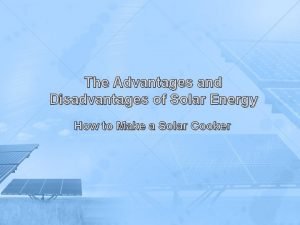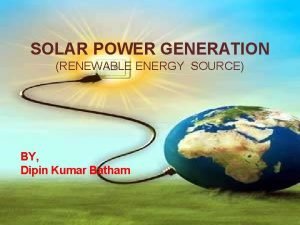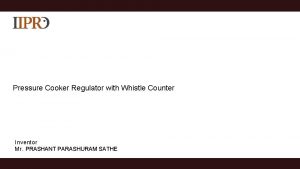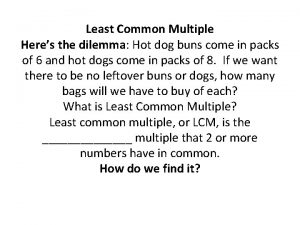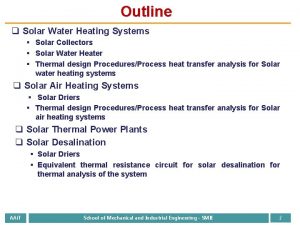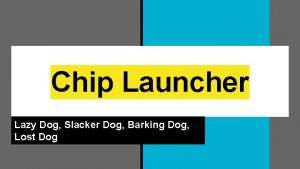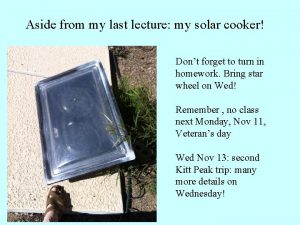Solar Hot Dog Cooker Matt Kesich Introduction We












- Slides: 12

Solar Hot Dog Cooker Matt Kesich

Introduction We used http: //explorelearning. com to create our parabola to fit into the box. u Our goal was to create a successful parabolic solar cooker out of simple materials such as cardboard and a reflective material. u

How it Works The sunlight and heat is reflected off the Mylar, converging on the focus. u The skewer is placed through the focus so most of the heat will be transferred to the food, thus allowing it to cook much more rapidly. u

Equation/Method We used Method 2, which allowed us to use one of the two corner points of the box and the vertex, allowing us to not guess and check, but get it right the first time. u The equation we used was derived from y= ¼p(x-h)²+k. The formula to create our parabola was 23=¼p(022)²+1. The final equation of the line was y=0. 05 x²-2. 00 x+23. 00. u

Finding the Vertex and Focus We found the vertex by simply selecting where we wanted it to be located. We did not want it to be too high or too low, so we picked one towards the bottom but not all the way down. u

Materials u u u Cardboard Box Wooden Skewers Compass Scissors Protractor u u u Mylar Poster Board Ruler String Graph Paper

Building the Box Dimensions: u Length: 44 cm u Width: 28. 5 cm u Height: 23 cm u u First, we had to graph the points of the parabola onto the box so we would be able to see where to put the skewers. We started with the two corner points, (0, 23) and (44, 23), as well as the vertex, (22, 3. 5).

Building Cont. u u u After we graphed the points on both sides of the box, we punctured holes with the compass and ran the skewers through both sides of the box. Then, we covered the poster board with Mylar and placed it onto the skewers, forming a parabola. Finally, we found the focus and placed a skewer through it, which is where the food would be cooking.

Angle of Elevation and the Sun u u u We needed to figure out the elevation of the sun since we were only able to cook in the morning. We used the website http: //www. srrb. noaa. gov/highlights/sunri se/azel. html to find the exact angle of elevation of the sun. We then angled the box using a protractor and had the most direct amount of sunlight entering the box and converging on the focus.

Ideal/Poor Conditions for Solar Cooking u u u The most ideal place to use solar cookers is at the equator since most of the sun’s rays are hitting at that location. The least ideal place would be at the two poles since the least amount of sunlight is hitting there. Ideally, a day with no clouds would be the best, and the use of solar cookers is useless if it is cloudy and there is no sunlight.

Other Uses of Solar Paraboloids Satellite Dishes for TV/Internet/Radio/etc. u Communications through space u

Was it Successful? u Our box that we built was successful because all of the sunlight converged on the focus where it was supposed to, working perfectly as planned.
 Solar hotdog cooker
Solar hotdog cooker Solar cooker advantages and disadvantages
Solar cooker advantages and disadvantages Conclusion of solar energy
Conclusion of solar energy Cooker whistle counter app
Cooker whistle counter app What is standard pressure
What is standard pressure Acetion
Acetion Complement
Complement Break down an inch
Break down an inch Hcf and lcm khan academy
Hcf and lcm khan academy Wholesale solar panel
Wholesale solar panel An inexhaustible source of energy
An inexhaustible source of energy Solar water heat exchanger
Solar water heat exchanger White hot vs red hot temperature
White hot vs red hot temperature

